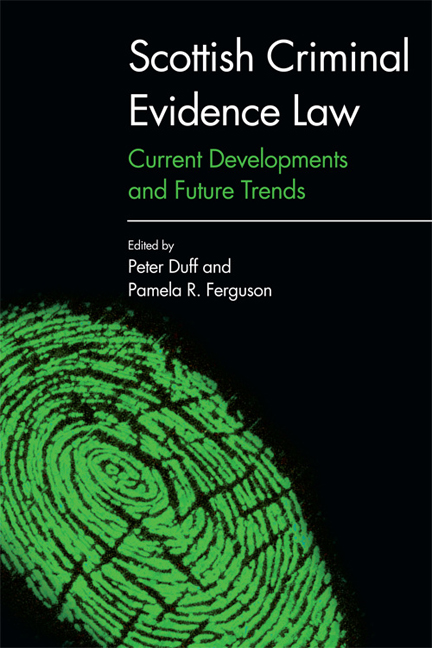Book contents
- Frontmatter
- Contents
- The Contributors
- Acknowledgements
- Table of Cases
- Table of Legislation
- Introduction
- 1 Cadder and Beyond: Suspects’ Rights and the Public Interest
- 2 ‘Access to Justice’ for Complainers? The Pitfalls of the Scottish Government’s Case to Abolish Corroboration
- 3 The Relevance of Sexual History and Vulnerability in the Prosecution of Sexual Offences
- 4 ‘Similar Fact’ Evidence and Moorov: Time For Rationalisation?
- 5 Hearsay in Scots law: Rethinking and Reforming
- 6 Eyewitness Identification Evidence and its Problems: Recommendations for Change
- 7 Assessing Witness Credibility and reliability: Engaging Experts and Disengaging Gage?
- 8 The process of Criminal Evidence Law Reform in Scotland: what Can We Learn?
- 9 Scottish Criminal Evidence Law Adrift?
- Bibliography
- Index
8 - The process of Criminal Evidence Law Reform in Scotland: what Can We Learn?
Published online by Cambridge University Press: 24 April 2021
- Frontmatter
- Contents
- The Contributors
- Acknowledgements
- Table of Cases
- Table of Legislation
- Introduction
- 1 Cadder and Beyond: Suspects’ Rights and the Public Interest
- 2 ‘Access to Justice’ for Complainers? The Pitfalls of the Scottish Government’s Case to Abolish Corroboration
- 3 The Relevance of Sexual History and Vulnerability in the Prosecution of Sexual Offences
- 4 ‘Similar Fact’ Evidence and Moorov: Time For Rationalisation?
- 5 Hearsay in Scots law: Rethinking and Reforming
- 6 Eyewitness Identification Evidence and its Problems: Recommendations for Change
- 7 Assessing Witness Credibility and reliability: Engaging Experts and Disengaging Gage?
- 8 The process of Criminal Evidence Law Reform in Scotland: what Can We Learn?
- 9 Scottish Criminal Evidence Law Adrift?
- Bibliography
- Index
Summary
INTRODUCTION
This chapter analyses law reforms that have taken place in the field of criminal evidence in modern-day Scotland. It does so at a busy time in the law reform arena, with two recent projects having the potential to radically change the landscape of Scottish criminal evidence. The chapter charts the main law reform projects and their outcomes and, drawing on these experiences, identifies the lessons that might be learned. The focus is on three areas: the bodies that might undertake law reform projects and the strengths and weaknesses of each; how projects might best be selected by those bodies; and how success might best be evaluated.
A. CHARTING THE TERRITORY
At the outset, it should be said that our focus is on law reform projects, not law reform that takes place as a result of judicial decisions. There have, undoubtedly, been occasions on which the Scottish courts have engaged in a degree of criminal evidence law reform, either by developing the common law or by interpreting legislation, but the focus of this chapter is on law reform exercises undertaken outside the courts.
As such, our initial task was to identify all Scottish law reform projects with a criminal evidence component since the 1970s. The results of this exercise are contained in the Appendix, which charts these projects – and their outcomes – in chronological order. The table is inclusive – as the Appendix shows, sometimes a project had only a small evidential component.
The first major project – probably still the most extensive – was the Thomson Committee's examination of criminal procedure in the 1970s, in which a team of thirteen members was appointed to ‘examine trial and pre-trial procedures in Scotland (including appeal procedure)’. Three reports were issued, leading to a number of significant changes, including the introduction of the modern regime governing the detention of suspects for questioning.
- Type
- Chapter
- Information
- Scottish Criminal Evidence LawCurrent Developments and Future Trends, pp. 194 - 223Publisher: Edinburgh University PressPrint publication year: 2017



